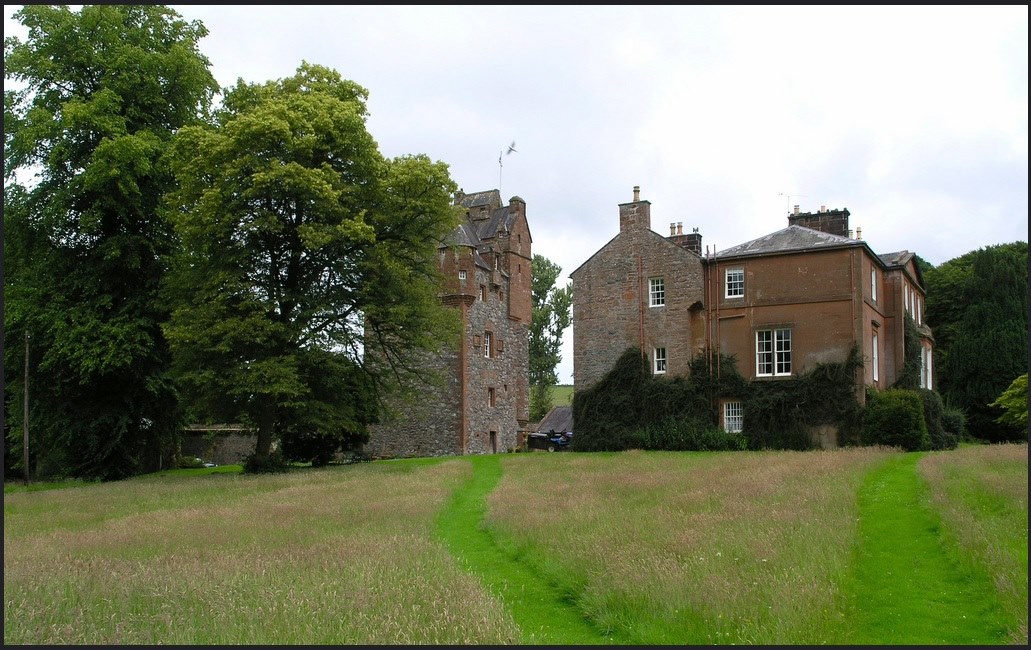Amisfield Tower

Amisfield Tower Details
Amisfield Tower, occupied C16 tower of the Charteris family extended in flamboyant style C17
- Closest To: Dumfries
- Access: Occasional Access
- Grid Reference: NX992838
Amisfield Tower is a justifiably famed tower house in Dumfries-shire with an exceptional level of architectural complexity at the upper levels, with corbelling and turrets galore. It was built for the Charteris family, with work commencing in the 16th century, and remains an occupied building which is available for hire as a venue. It cannot be seen clearly from public roads, and sits within modest private grounds to the north-west of the village of Amisfield. The square tower is entered through a door in the south wall at ground floor level, where a small lobby leads to the vaulted cellar and a mural staircase. This stair leads to the first floor hall, which takes up the whole first floor, and the landing accesses a winding stair in the south-east corner, which is contained within a turret projecting slightly from the corner of the building. This hall had a mezzanine layer above, and the winding stair continues upwards to serve the third floor. At this level, corbelling supports the conversion of the round turret to a square one, and from this square turret a small lobby high above the front door accesses the third floor hall, provided with three round bartizan turrets at the other three corners. To the north, a smaller winding stair, again corbelled out into a small turret, leads up to the fourth floor, where a chamber sits in the square turret, and small rooms are contained in the round ones. The winding stair continues to access a watch room at fifth floor level in the square turret, and a narrow mural stair leads to a final watch turret at the very top of the building, more than 20 metres above the ground level.
The Charteris family were granted the lands of Amisfield in the 12th century, probably granted to them by the Bruce Lords of Annandale. There was a castle here in the 13th century, briefly held by the Earl of Warwick when the Charteris lord joined the rebellion of 1298. By 1306 Andrew de Charteris was restored, helping to hold Dumfries Castle for the English, but in 1314 his son Robert fought with Bruce at Bannockburn. No evidence of this early castle survives, unless it is hidden by 18th century landscaping – this includes the “moated homestead” recorded by the Ordnance Survey. The family continued to hold the lands of Amisfield through the superiority of the Randolphs, Dunbars and Douglases, and then directly from the Crown. During the early 16th century, Robert Charteris (d1506) or his grandson John (d1535) erected the earliest tower here, and this was probably damaged during the Rough Wooing to be rebuilt on a larger scale – the first floor hall is representative of this phase, although evidence of floor level changes suggest another largely unknown phase of construction beforehand, perhaps related to the Act of Parliament of 1535 defining what all border towers should look like as a minimum. A fourth phase of building was completed for Sir John Charteris in 1600, which includes the decorative masonry and turrets of the upper floors. In 1631, a new house was founded adjacent to the tower by another Sir John. Regrettably this proved too expensive for his finances, and he was forced to wadset the property to John Dalzell of Newton in 1636, two years before his death. His son (yet another John) eventually sold the estate outright to Dalzell in 1649, having further damaged his finances during the previous wars, dying in 1654. In 1677, Thomas Charteris, third son of the last John, repurchased the estate, and the Charteris family then lived at Amisfield until 1834, when the mansion house was provided with a new front facade. The tower remained in generally good condition, although unused, but by the 1920s had no windows and the floors were unsafe. The tower was restored by Major William Johnstone, whose father had purchased the estate, and his descendants remain resident at Amisfield today.
Become a supporter of my work to access a more detailed history